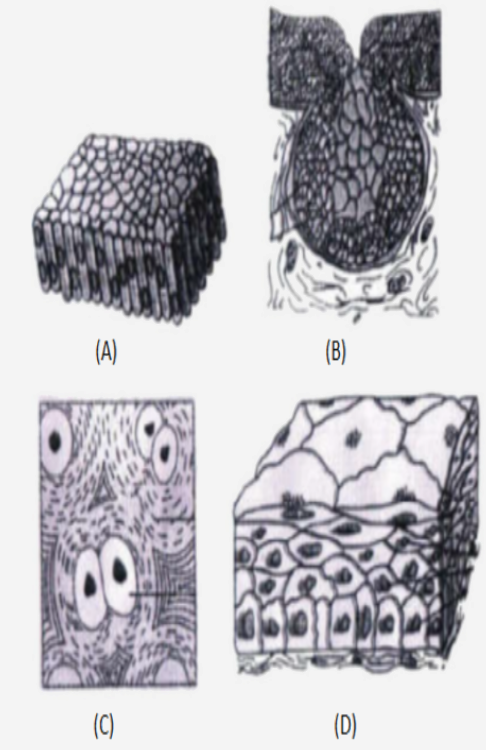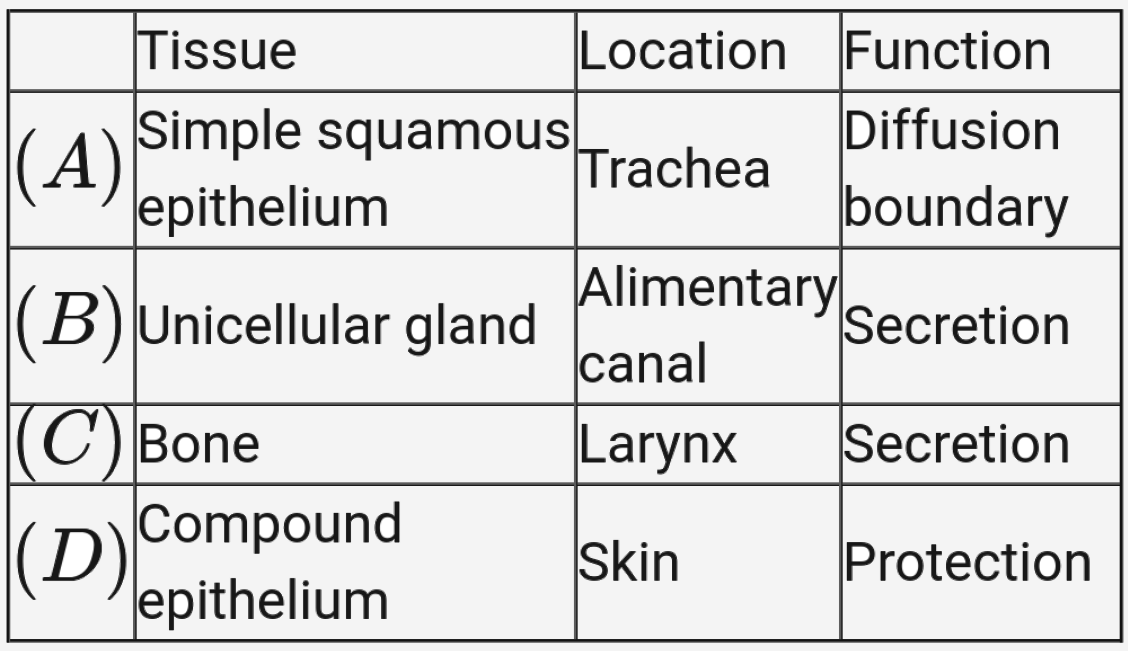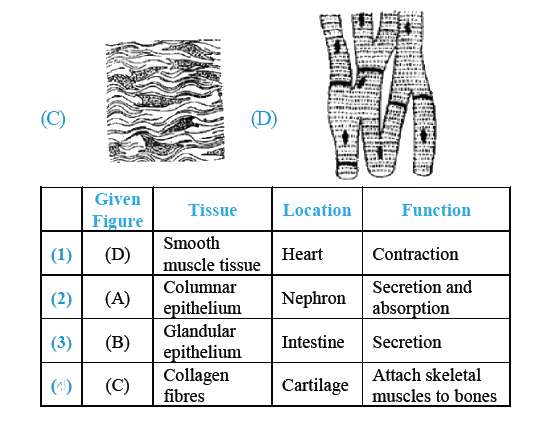Which are the four types of animal tissues ?
Epithelial, squamous, muscular, connective
Epithelial, connective, muscular, cardiac
Connective, muscular, epithelial, nervous
Cuboidal, ciliated, glandular, columnar
The correct Answer is:B
To answer the question about the four types of animal tissues, we can break it down step by step:
1. Identify the Types of Animal Tissues:
- Animal tissues are classified into four main types: epithelial, connective, muscular, and nervous tissues.
2. Epithelial Tissue:
- Epithelial tissue serves several functions, including protection, secretion, absorption, excretion, filtration, diffusion, and sensory reception. It forms the outer layer of the skin and lines internal organs and cavities.
3. Connective Tissue:
- Connective tissue supports, binds together, and protects tissues and organs of the body. It includes various types such as bone, blood, adipose (fat) tissue, and cartilage.
4. Muscular Tissue:
- Muscular tissue is responsible for movement. There are three types of muscular tissue: skeletal (voluntary), smooth (involuntary), and cardiac (heart muscle).
5. Nervous Tissue:
- Nervous tissue is involved in receiving stimuli and transmitting electrical impulses throughout the body. It consists of neurons and supporting cells called glial cells.
Final Answer:
The four types of animal tissues are:
1. Epithelial Tissue
2. Connective Tissue
3. Muscular Tissue
4. Nervous Tissue
---
- Animal tissues are classified into four main types: epithelial, connective, muscular, and nervous tissues.
- Epithelial tissue serves several functions, including protection, secretion, absorption, excretion, filtration, diffusion, and sensory reception. It forms the outer layer of the skin and lines internal organs and cavities.
- Connective tissue supports, binds together, and protects tissues and organs of the body. It includes various types such as bone, blood, adipose (fat) tissue, and cartilage.
- Muscular tissue is responsible for movement. There are three types of muscular tissue: skeletal (voluntary), smooth (involuntary), and cardiac (heart muscle).
- Nervous tissue is involved in receiving stimuli and transmitting electrical impulses throughout the body. It consists of neurons and supporting cells called glial cells.
The four types of animal tissues are:
1. Epithelial Tissue
2. Connective Tissue
3. Muscular Tissue
4. Nervous Tissue
Topper's Solved these Questions
- BOOK - AGRAWAL EXAM CART BIHARCHAPTER - CELL STRUCTURE AND FUNCTIONSEXERCISE - Important Question44videos
CELL STRUCTURE AND FUNCTIONS
- BOOK - AGRAWAL EXAM CART BIHARCHAPTER - ASEXUAL AND SEXUAL REPRODUCTIONEXERCISE - IMPORTANT QUESTIONS48videos
ASEXUAL AND SEXUAL REPRODUCTION
- BOOK - AGRAWAL EXAM CART BIHARCHAPTER - CONSERVATION OF PLANTS AND ANIMALS (BIOSPHERE RESERVES, NATIONAL PARKS AND WILDLIFE SANCTURAIES)EXERCISE - Important Questions47videos
CONSERVATION OF PLANTS AND ANIMALS (BIOSPHERE RESERVES, NATIONAL PARKS AND WILDLIFE SANCTURAIES)
Similar Questions
Write the 4 types of animals tissues.
View SolutionList four types of animal tissues.
View SolutionWrite the 4 types of animals tissues.
View SolutionWhat are the various types of animal tissues? Mention briefly the location and one main function of each type of tissues.
View SolutionWhat are the various types of animal tissues? Mention briefly the location and one main function of each type of tissues.
View SolutionEnumerate four main types of animal tissues.
View SolutionThe four sketches (A, B, C and D) given below represent four different types of animal tissues .
Which one of these is correctly identified in the options given along with its correct location and function?

 View Solution
View SolutionWhich is the most abundant type of animal tissue?
View SolutionThe four figures (A, B, C and D) given below represent four different types of animal tissues. Which one of these is correctly identified in the given options along with its correct location and function ?
 View Solution
View SolutionThe four sketches (A, B, C and D) given below, represent four different types of animal tissues. Which one of these is correctly identified in the options given, along with its correct location and function ?

 View Solution
View Solution
